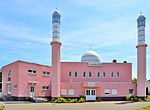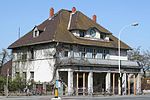Darmstadt Hauptbahnhof
Art Nouveau architecture in GermanyArt Nouveau railway stationsRailway stations in DarmstadtRailway stations in Germany opened in 1912Rhine-Main S-Bahn stations

Darmstadt Hauptbahnhof is the main railway station in the German city Darmstadt. After Frankfurt Hbf and Wiesbaden Hbf, it is the third largest station in the state of Hesse with 35,000 passengers and 220 trains per day. Built in a late art nouveau style, the station was finished 1912 as one of the major works of architect Friedrich Pützer. The station replaced two separate and increasingly inadequate stations located at the Steubenplatz, around a km closer to the city centre in the east.
Excerpt from the Wikipedia article Darmstadt Hauptbahnhof (License: CC BY-SA 3.0, Authors, Images).Darmstadt Hauptbahnhof
Am Hauptbahnhof, Darmstadt Darmstadt-Nord (Darmstadt-Nord)
Geographical coordinates (GPS) Address Nearby Places Show on map
Geographical coordinates (GPS)
| Latitude | Longitude |
|---|---|
| N 49.8725 ° | E 8.6294444444444 ° |
Address
Am Hauptbahnhof 20
64293 Darmstadt, Darmstadt-Nord (Darmstadt-Nord)
Hesse, Germany
Open on Google Maps










